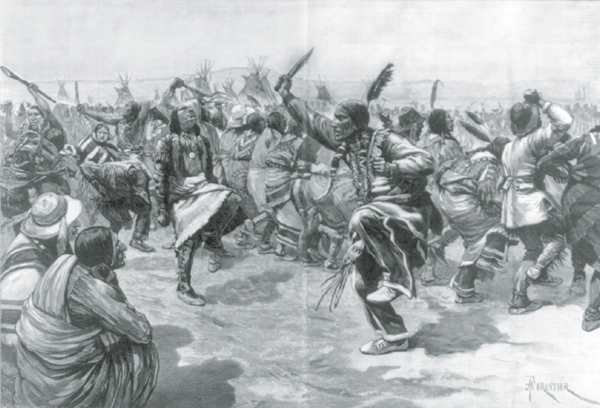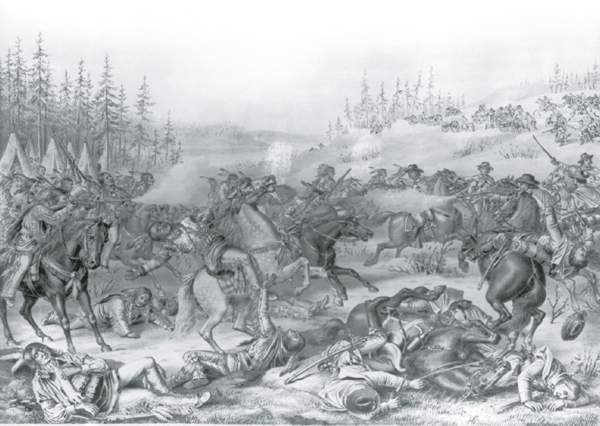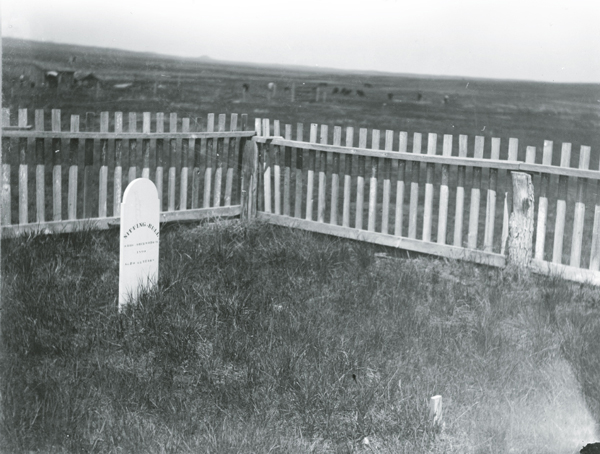
Then medicine man tell Indians to send word to all Indians to keep up dancing and the good time will come.
—WOVOKA, PAIUTE FOUNDER OF THE GHOST DANCE MOVEMENT

For many years, white missionaries had tried to persuade Indians to abandon their tribal religions and convert to Christianity. Many tribes did. What missionaries did not expect was that some Indians might take the stories of Christ and the Resurrection and combine them with tribal beliefs to create a new religion. But in 1889 that is what happened in Nevada. Word of this new religion traveled east to the reservations of the Sioux, and in the early fall of 1890, some decided to go to Nevada and learn about it.
In the Drying Grass Moon, on October 9, 1890, a Minneconjou from the Cheyenne River agency came to Standing Rock to visit Sitting Bull. His name was Kicking Bear, and he brought news of the Paiute Messiah, Wovoka, who had founded the religion of the Ghost Dance.
Kicking Bear told Sitting Bull of how a voice had commanded him to go forth and meet the ghosts of Indians who were to return and inhabit the earth. On the cars of the Iron Horse, he and Short Bull and nine other Sioux had traveled far toward the place where the sun sets, traveled until the railroad stopped. There they were met by two Indians they had never seen before, but who greeted them as brothers and gave them meat and bread. They supplied the pilgrims with horses and they rode for four suns until they came to a camp of Fish Eaters (Paiutes) near Pyramid Lake in Nevada.
The Fish Eaters told the visitors that Christ had returned to the earth again. Christ must have sent for them to come there, Kicking Bear said; it was destined to happen. To see the Messiah they had to make another journey to the agency at Walker Lake about 100 miles to the southeast.
For two days, Kicking Bear and his friends waited at Walker Lake with hundreds of other Indians speaking in dozens of different tongues. These Indians had come from many reservations to see the Messiah.
Just before sundown on the third day, Christ appeared, and the Indians made a big fire to throw light on him. Kicking Bear had always thought that Christ was a white man like the missionaries, but this man looked like an Indian. After a while he rose and spoke to the waiting crowd. “I have sent for you and am glad to see you,” he said. “I am going to talk to you after a while about your relatives who are dead and gone. My children, I want you to listen to all I have to say to you. I will teach you how to dance a dance, and I want you to dance it. Get ready for your dance, and when the dance is over, I will talk to you.” Then he commenced to dance. Soon everybody joined in, the Messiah singing while they danced. They danced the Dance of the Ghosts until late at night, when the Messiah told them they had danced enough.
Next morning, Kicking Bear and the others went up close to the Messiah to see if he had the scars of crucifixion, which the missionaries on the reservations had told them about. There was a scar on his wrist and one on his face, but they could not see his feet because he was wearing moccasins. Throughout the day he talked to them. In the beginning, he said, God made the earth, and then sent Christ to earth to teach the people, but white men had treated him badly, leaving scars on his body, and so he had gone back to heaven. Now he had returned to earth as an Indian, and he was to renew everything as it used to be and make it better.
In the next springtime, when the grass was knee high, the earth would be covered with new soil that would bury all the white men, and the new land would be covered with sweet grass and running water and trees. Great herds of buffalo and wild horses would come back. The Indians who danced the Ghost Dance would be taken up in the air and suspended there while a wave of new earth was passing, and then they would be set down among the ghosts of their ancestors on the new earth, where only Indians would live.
After a few days at Walker Lake, Kicking Bear and his friends learned how to dance the Ghost Dance, and then they mounted their horses to return to the railroad. As they rode along, Kicking Bear said, the Messiah flew above them in the air, teaching them songs for the new dance. At the railroad, he left them, telling them to return to their people and teach what they had learned. When the next winter was passed, he would bring the ghosts of their fathers to meet them in the new resurrection.
After returning to Dakota, Kicking Bear had started the new dance at Cheyenne River, Short Bull had brought it to Rosebud, and others were introducing it at Pine Ridge. Big Foot’s band of Minneconjous, Kicking Bear said, was made up mostly of women who had lost husbands or other male relatives in battle. They danced until they fainted because they wanted to bring their dead warriors back.

An 1891 Illustrated London News wood engraving of Sioux Indians performing the Ghost Dance. [LOC, USZ62-52423]
Sitting Bull listened to all that Kicking Bear had to say about the Messiah and the Ghost Dance. He did not believe it was possible for dead men to return and live again, but his people had heard of the Messiah and were fearful he would pass them by and let them disappear when the new resurrection came, unless they joined in the dancing. Sitting Bull had no objections to his people dancing the Ghost Dance, but he had heard that agents at some reservations were bringing soldiers in to stop the ceremonies. He did not want soldiers coming in to frighten, and perhaps shoot guns at, his people. Kicking Bear replied that if the Indians wore the sacred garments of the Messiah—Ghost Shirts painted with magic symbols—no harm could come to them. Not even the bullets of the Bluecoats’ guns could penetrate a Ghost Shirt.
With some skepticism, Sitting Bull invited Kicking Bear to remain with his band at Standing Rock and teach them the Dance of the Ghosts. Across the West, on almost every Indian reservation, the Ghost Dance spread like a prairie fire in a high wind. Agitated Indian Bureau inspectors and army officers from Dakota to Arizona, from Indian Territory to Nevada, were scared. Soon the official word was “Stop the Ghost Dancing.”
“A more [dangerous] system of religion could not have been offered to a people who stood on the threshold of civilization,” White Hair McLaughlin said. Although he was a practicing Catholic, McLaughlin, like most other agents, failed to recognize the Ghost Dance’s similarity to the Christian faith.
A week after Kicking Bear came to Standing Rock, White Hair McLaughlin sent a dozen Indian police to remove him from the reservation. Awed by Kicking Bear’s aura of holiness, the policemen referred McLaughlin’s order to Sitting Bull, but the chief refused to take action. On October 16, McLaughlin sent a larger force of police, and this time Kicking Bear was escorted off the reservation.
The following day McLaughlin notified the commissioner of Indian Affairs that the real power behind the “pernicious system of religion” at Standing Rock was Sitting Bull. He recommended that the chief be arrested, removed from the reservation, and confined to a military prison. The commissioner conferred with the secretary of war, and they decided that such action would create more trouble than it would prevent.
By mid-November, Ghost Dancing was so widespread on the Sioux reservations that almost all other activities came to a halt. Government agents were terrified and pleaded for military help. On November 20, the Indian Bureau in Washington ordered reservation agents to telegraph the names of all the leaders of the disturbances. That list was then transmitted to Bear Coat Miles’s army headquarters in Chicago. Miles saw Sitting Bull’s name and immediately assumed that he was to blame.
Meanwhile, at Pine Ridge, the army had already brought in troops, creating a tense situation between the Indians and the military. A former agent, Dr. Valentine McGillycuddy, was sent there to make recommendations for a resolution of the difficulties. “I should let the dance continue,” McGillycuddy said. “The coming of the troops has frightened the Indians. If the Seventh-Day Adventists prepare their ascension robes for the second coming of the Savior, the United States Army is not put in motion to prevent them. Why should not the Indians have the same privilege? If the troops remain, trouble is sure to come.” This viewpoint, however, was not to prevail. On December 12, Lieutenant Colonel William F. Drum, who was commanding troops at Fort Yates, received orders from General Miles “to secure the person of Sitting Bull.”
On December 15, 1890, just before daybreak, 43 Indian police surrounded Sitting Bull’s log cabin. Three miles away a squadron of cavalry waited as a support force if needed. Lieutenant Bull Head, the Indian policeman in charge of the party, found Sitting Bull asleep on the floor. When he was awakened, the chief asked, “What do you want here?”
“You are my prisoner,” said Bull Head. “You must go to the agency.”
Sitting Bull yawned and sat up. “All right,” he replied. “Let me put on my clothes, and I’ll go with you.” He asked the policemen to have his horse saddled.
When Bull Head emerged from the cabin with Sitting Bull, he found a crowd of Ghost Dancers gathering outside. They outnumbered the police four to one. Catch-the-Bear, one of the dancers, moved toward Bull Head. “You think you are going to take him,” Catch-the-Bear shouted. “You shall not do it!”
“Come now,” Bull Head said quietly to his prisoner, “do not listen to anyone.” But Sitting Bull held back, making it necessary for Bull Head and his associate, Sergeant Red Tomahawk, to force him toward his horse.
At this moment, Catch-the-Bear threw off his blanket and brought up a rifle. He fired at Bull Head, wounding him in the side. As Bull Head fell, he tried to shoot his assailant, but the bullet struck Sitting Bull instead. Almost simultaneously, Red Tomahawk shot Sitting Bull through the head and killed him.

This 1891 lithograph from a Chicago printmaking company called Kurz & Allison is titled Capture & Death Of Sitting Bull. It is another example of an inaccurate and romanticized interpretation of an event involving Native Americans. [LOC, DIG-pga-01896]

Sitting Bull’s original grave in Fort Yates, North Dakota, in 1906. In 1953, residents of nearby Mobridge, South Dakota, claimed to have dug up his grave and reburied his remains near their town under a 20-ton block of concrete. They said the purpose was to move him closer to his birthplace. Historians and some Sioux leaders believe that the remains buried in Mobridge were not those of Sitting Bull. [LOC, USZ62-104929]
During the firing, the old show horse that Buffalo Bill had presented to Sitting Bull began to go through his tricks. He sat upright, raised one hoof, and it seemed to those who watched that he was performing the Dance of the Ghosts. When the horse ceased his dancing and wandered away, the wild fighting resumed. Only the arrival of the nearby cavalry detachment saved the Indian police from death.
